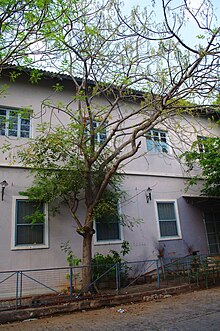| Garuga | |
|---|---|

| |
| Habit | |
 Least Concern (IUCN 3.1) | |
| Scientific classification | |
| Kingdom: | Plantae |
| Clade: | Tracheophytes |
| Clade: | Angiosperms |
| Clade: | Eudicots |
| Clade: | Rosids |
| Order: | Sapindales |
| Family: | Burseraceae |
| Genus: | Garuga |
| Species: | G. floribunda |
| Binomial name | |
| Garuga floribunda Decne. | |
| Synonyms | |
| |
Garuga floribunda, commonly known as garuga, is a plant in the frankincense and myrrh family Burseraceae, with a broad distribution from northeastern India through southeast Asia and northern Australia to the southwestern Pacific. It is a tree up to 36 m (118 ft) tall and a trunk diameter up to 90 cm (35 in). The compound leaves are about 38 cm (15 in) long, arranged spirally and clustered near the tips of the branches. The leaflets are odd in number, with dentate margins, and measure up to 10 cm (3.9 in) long by 5 cm (2.0 in) wide.
The inflorescence is a branched panicle carrying numerous flowers, each about 5 mm (0.20 in) long with five sepals and five white to yellow petals. There are ten stamens and a single style. The fruit is a drupe up to 17 mm (0.7 in) long and 25 mm (1.0 in) wide, green to black, containing a jelly-like flesh and up to five seeds.
Taxonomy
This species was first described in 1834 by the French botanist Joseph Decaisne, and published in the journal Nouvelles Annales du Museum d'Histoire Naturelle.
Distribution and habitat
The tree is found from Bangladesh in northeastern India through to south and central China (including the island of Hainan), and south to Laos, Thailand, all of Malesia except Sumatra, New Guinea, the Solomon Islands, Samoa, Tonga, Vanuatu, and the Australian states of Western Australia and Queensland. It inhabits drier rainforest types such as monsoon forest and gallery forest up to about 400 m (1,300 ft) altitude.
Conservation
As of September 2024, this species has been assessed to be of least concern by the International Union for Conservation of Nature (IUCN), as well as under the Queensland Government's Nature Conservation Act.
Gallery
References
- ^ Botanic Gardens Conservation International (BGCI); IUCN SSC Global Tree Specialist Group. (2018). "Garuga floribunda". IUCN Red List of Threatened Species. 2018: e.T201772A135803946. doi:10.2305/IUCN.UK.2018-2.RLTS.T201772A135803946.en. Retrieved 1 September 2024.
- "Garuga floribunda". Australian Plant Name Index (APNI). Centre for Australian National Biodiversity Research, Australian Government. Retrieved 1 September 2024.
- ^ "Garuga floribunda Decne". Plants of the World Online. Royal Botanic Gardens, Kew. 2024. Retrieved 1 September 2024.
- ^ F.A.Zich; B.P.M.Hyland; T.Whiffen; R.A.Kerrigan (2020). "Garuga floribunda". Australian Tropical Rainforest Plants Edition 8 (RFK8). Centre for Australian National Biodiversity Research (CANBR), Australian Government. Retrieved 1 September 2024.
- ^ B.J. Conn; R. Banka; L.L. Lee (2024). "PNGTreesKey – Garuga floribunda Decne". Plants of Papua New Guinea. National Herbarium of New South Wales. Retrieved 1 September 2024.
- ^ Cooper, Wendy; Cooper, William T. (June 2004). Fruits of the Australian Tropical Rainforest. Clifton Hill, Victoria, Australia: Nokomis Editions. p. 96. ISBN 978-0-9581742-1-3.
- Decaisne, Joseph (1834). "Description d'un herbier de l'Ile de Timor". Nouvelles Annales du Museum d'Histoire Naturelle (in Latin). 3: 477. Retrieved 1 September 2024.
- "Species profile—Garuga floribunda". Queensland Department of Environment and Science. Queensland Government. 2024. Retrieved 1 September 2024.
External links
- View a map of herbarium collections of this species at the GBIF
- View observations of this species on iNaturalist
- View images of this species on Flickriver.com




